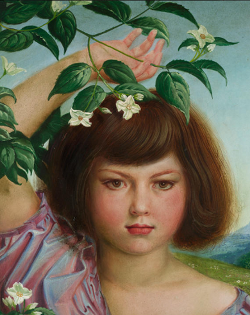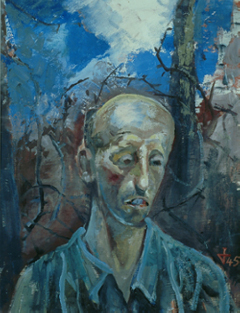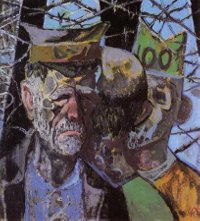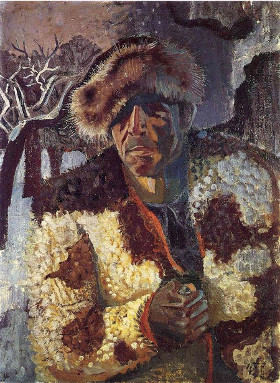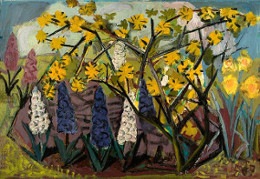Nelly As Flora
Year: 1940
Description: During the height of Nazi power, Dix went into inner exile. Like Thomas Mann, his views were at odds with the regime but he chose to remain in Germany after 1933. In order to avoid confrontation, he conformed outwardly with the regime. Dix was in his 40s with a wife and children when the Nazis came to power. It's easy to empathize.
At the same time, the Nazis effectively ended his extraordinary post-war run. Dix buried expressionism when once Hitler took control of the state. He tamed his style and softened his motifs.
This work is a typical example from the period. Dix portrays his daughter is soft tones surrounded by gentle flora. It would not be out of place in a room full of Thomas Kincaids. The artist remained in Germany in order to support himself with work that at times was close to kitsch. It was a decision that would place a 13 year void in the middle of his career.
Provenance: Private Collection, Canada
- Sold: Bonhams, London 2005
- Exhibition: St Paul de Vence, Fondation Maeght,
- Otto Dix: Metropolis, 2 July - 18 October 1998
Portrait of a Prisoner
Year: 1945
Description: When the NSDAP came to power, Dix was forced into self-imposed exile near the Swiss border. The new regime branded him a degenerate and destroyed as much of his art as they could find. Fortunately for posterity, many of his pieces were in private collections.
In the final stages of the war, Dix was conscripted into the Volkssturm, a military homeguard comprised of young boys and old men. He was soon captured by the French and spent the duration in a POW camp. Dix was granted access to materials and he painted a triptych for the prison chapel. Portrait of a Prisoner was completed inside the camp.
The prisoner is a sympathetic figure. Dix forgot his tendency to accentuate his subject's worst features. After the war, his art would take on a strong relgious tone. Here we find a foreshadowing of that tendency as barb wire creates the prisoner's crown of thorns.
Provenance:
Private Collection
Self-portrait as a Prisoner of War
Selbstbildnis als Kriegsgefangener
Year: 1947
Description:
As Nazi Germany collapsed, Otto Dix was drafted into Volkssturm along with other old men and young boys. He was promptly captured and ended the war in a French POW camp. While in the camp, he was granted access to art materials which he used to paint a triptych for the prison chapel. While he did create work inside the camp, this portrait was done from memory after his release. Prisoner Dix is an old man with a deeply lined face, troubled by his circumstances. His stoic demeanor is contrasted with that of the Fool behind him.
During this period, he undergoes stylistic changes. His brush strokes become shorter and end more abruptly. The overview is more shredded and porous. Dix was trying to remain relevent as another human tragedy brought its influence to bear on 20th Century art.
Provenance: Public Museum
- Galerie der Stadt, Stuttgart (on loan)
- Löffler 1947/2
- Oil on pressed fiberboard
Self-portrait in Fur Cap against Winter Landscape
Selbstbildnis mit Pelzkappe vor Winterlandschaft
Year: 1947
Description: When the Third Reich fell at the end of the Second World War, Dix was freed from the Nazi's artistic oppression yet his style never regained its Interwar edge.
His war, the First World War was a distant memory and Dix didn't seem to have much stomach for the depicting the Second. His late period is characterized by a large number of self-portraits. This one, from a private collection in France, is considered among the most important.
Rembrandt famously depicted himself in a fur hat. So did Vincent van Gogh. Like both those artists, Dix pays particular attention to the details of material texture. The fur cap, the heavy jacket and leather gloves overwhelm the artist's face and hands. This was a remarkable departure from his portraiture statements during the 1920s.
Provenance: Private Collection
- Unknown collector, France
- Löffler 1947/3
- Oil on plywood
Garden In Spring
Garten Im Fruehling
Year: 1957
Description: Late in his career, Dix turned his attention away from the war.
Provenance: Private Collection
- Sotheby's 2003
- Van Ham Fine Art Auctions 2008
- Lehr Kunstauktionen Berlin 2009
-
Björn Sjöling
-
http://radarman1946.tumblr.com/ Melvin
-
Alice Rohr
-
Richard Foran
-
Richard Foran
-
Richard von Bitter
-
Karl Gauss
